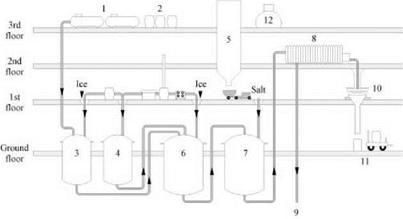The basic steps of dye (and intermediate) manufacture are shown in Figure 1.1. There are usually several reaction steps or unit processes.
The reactor itself, in which the unit processes to produce the intermediates and dyes are carried out, is usually the focal point of the plant, but this does not mean that it is the most important part of the total manufacture, or that it absorbs most of the capital or operational costs. Operations subsequent to reaction are often referred to as workup stages. These vary from product to product, whereby intermediates (used without drying wherever practical) require less finishing operations than colorants.
The reactions for the production of intermediates and dyes are carried out in bomb-shaped reaction vessels made from cast iron, stainless steel, or steel lined with rubber, glass (enamel), brick, or carbon blocks. These vessels have capacities of 2-40 m3 (ca 500-10 000 gallons) and are equipped with mechanical agitators, thermometers, or temperature recorders, condensers, pH probes, etc., depending
|
Figure 1.1. Operation sequence in dye and intermediate manufacture. |
on the nature of the operation. Jackets or coils are used for heating and cooling by circulation of high-boiling fluids (e. g. hot oil or Dowtherm), steam, or hot water to raise the temperature, and air, cold water, or chilled brine to lower it. Unjacketed vessels are often used for reactions in aqueous solutions in which heating is effected by direct introduction of steam, and cooling by addition of ice or by heat exchangers. The reaction vessels normally span two or more floors in a plant to facilitate ease of operation.
Products are transferred from one piece of equipment to another by gravity flow, pumping, or blowing with air or inert gas. Solid products are separated from liquids in centrifuges, in filter boxes, on continuous belt filters, and, perhaps most frequently, in various designs of plate-and-frame or recessed-plate filter presses. The presses are dressed with cloths of cotton, Dynel, polypropylene, etc. Some provide separate channels for efficient washing, others have membranes for increasing the solids content of the presscake by pneumatic or hydraulic squeezing. The plates and frames are made of wood, cast iron, but more usually hard rubber, polyethylene, or polyester.
When possible, the intermediates are used for the subsequent manufacture of other intermediates or dyes without drying because of saving in energy costs and handling losses. This trend is also apparent with dyes. The use of membrane technology with techniques such as reverse osmosis to provide pure, usually aqueous, solutions of dyes has become much more prevalent. Dyes produced and sold as liquids are safer and easier to handle and save energy costs.
However, in some cases products, usually in the form of pastes discharged from a filter, must be dried. Even with optimization of physical form, the water content of pastes varies from product to product in the range of 20-80 %. Where drying is required, air or vacuum ovens (in which the product is spread on trays), rotary dryers, spray dryers, or less frequently drum dryers (flakers) are used. Spray dryers have become increasingly important. They require little labor and accomplish rapid drying by blowing concentrated slurries (e. g., reaction masses) through a small orifice into a large volume of hot air. Dyes, especially disperse dyes, that require wet grinding as the penultimate step are now often dried this way. In this case their final standardization, i. e., addition of desired amounts of auxiliary agents and solid diluents, is performed in the same operation.
The final stage in dye manufacture is grinding or milling. Dry grinding is usually carried out in impact mills (Atritor, KEK, or ST); considerable amounts of dust are generated and well-established methods are available to control this problem. Dry grinding is an inevitable consequence of oven drying, but more modem methods of drying, especially continuous drying, allow the production of materials that do not require a final comminution stage. The ball mill has been superseded by sand or bead mills. Wet milling has become increasingly important for pigments and disperse dyes. Many patented designs, particularly from Drais- werke GmbH and Gebruder Netzsch, consist of vertical or horizontal cylinders equipped with high-speed agitators of various configurations with appropriate continuous feed and discharge arrangements. The advantages and disadvantages of vertical and horizontal types have been discussed [7]; these are so finely balanced as to lead to consideration of tilting versions to combine the advantages of both.
In the past the successful operation of batch processes depended mainly on the skill and accumulated experience of the operator. This operating experience was difficult to codify in a form that enabled full use to be made of it in developing new designs. The gradual evolution of better instrumentation, followed by the installation of sequence control systems, has enabled much more process data to be recorded, permitting maintenance of process variations within the minimum possible limits.
Full computerization of multiproduct batch plants is much more difficult than with single-product continuous units because the control parameters very fundamentally with respect to time. The first computerized azo [8] and intermediates [9] plants were bought on stream by ICI Organic Division (now Avecia) in the early 1970s, and have now been followed by many others. The additional cost (ca. 10 %) of computerization has been estimated to give a saving of 30-45 % in labor costs [10]. However, highly trained process operators and instrument engineers are required. Figure 1.2 shows the layout of a typical azo dye manufacturing plant.
|
Figure 1.2 Layout of azo dye manufacturing plant. 1, storage tanks for liquid starting materials; 2, storage drums for solid starting materials; 3, diazotisation vessel; 4, coupling component vessel; 5, ice machine; 6, coupling vessel; 7, isolation vessel; 8, filter presses; 9, filtrate to waste liquor treatment plant; 10, dryers; 11, emptying of dyestuffs for feeding to the mill; 12, outgoing air purification plant. |
 17 августа, 2015
17 августа, 2015  Pokraskin
Pokraskin 

 Опубликовано в рубрике
Опубликовано в рубрике 